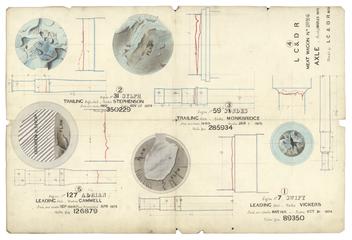
London, Chatham and Dover Railway Co
The London, Chatham and Dover Railway (LCDR) started out as an idea for the Central Kent railway, in around 1838 because it was seen to be desirable for the railway network to reach the principal towns and population of Kent.
Before this line became the LCDR it was made up of various lines built by the East Kent Railway Company. It started as the North Kent branch of the Central Kent Railway, running from Gravesend to Strood and in 1855, the East Kent Company was granted powers to extend to Dover. Between 1858 and 1861, further branches were added including lines from Strood to Chatham, Chatham to Faversham, Faversham to Canterbury and Canterbury to Dover Town (now Dover Priory).
In 1859, the East Kent Company received the go-ahead to extend to London, and from then the line was renamed the London, Chatham and Dover Railway line. In 1860, LCDR obtained powers to build its own line from Penge Junction to Battersea, which later joined Victoria Station and Pimlico, abolishing the need to use the lines of other companies and in 1871, LCDR was allowed to build a station on Holborn Viaduct, which they called Snow Hill. In 1878, the LCDR built a track from Buckland to Deal; however the junction at Buckland was the wrong way for Chatham and Dover trains from London to Deal, so a further line was built linking Dover and Deal, which was opened in June 1881, then in 1883, an extension of the line was built to reach Sheerness and in July 1884 and a Maidstone-Ashton branch was completed.
To compete with the South Eastern Railway Company line’s luxury “American Car Train,” The LCDR ran a “Club Train” from London to the coastal Kent resorts, between 1889 and 1893. Unlike South Eastern however, LCDR’s track was not as well-built, leading to a very bumpy ride for passengers. . During the last half of 1870, the Franco-German war severely affected Continental traffic, costing LCDR an estimated £28,000 and due to a shortage of rolling stock on the French railways, LCDR and South Eastern each lent the Northern of France Railway, twenty passenger carriages.
1874 was a bad year for LCDR financially, due to high coal prices, which increased locomotive expenses, and caused consumers to decrease their spending. In 1874, W.R. Sykes approached Forbes at LCDR to convince him to trial a “lock-and-block” signalling system, Forbes initially disregarded the idea as foolish, but the Board of Trade disagreed and by September 1881, LCDR was equipped as far as Faversham, and all the way to Dover, by June 1882.
The company's locomotive works was at Longhedge, just east of Clapham Junction, it was here that they built “F” class locomotives. Between Strood and Canterbury there were three tunnels and a bridge that crossed the Medway between Strood and Rochester. The Penge tunnel, was built from the London clay that it ran through – but the dimension of the tunnel were small, so for about seventy years there were limitations on which stock could use it. In 1877 LCDR built a hotel at their new Snow Hill station, Holborn.
The Locomotive Superintendents were: William Cubitt (1858-1860), William Martley (1860-1874), and William Kirtley (1874-1898). In 1861, James Staat Forbes (previously the resident manager and a director for the Dutch Rhenish Railway) came to LCDR as general manager. In 1873, he became Chairman and Managing Director.
In December 1922, the London, Chatham and Dover Railway was absorbed into the Southern Railway, as part of the grouping of the railways into the “Big Four.”